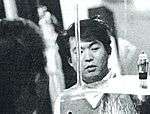Shusaku Arakawa
Shusaku Arakawa (荒川 修作, Arakawa Shūsaku, July 6, 1936 – May 18, 2010)[1] was a Japanese artist and architect. He had a personal and artistic partnership with writer and artist Madeline Gins that spanned more than four decades.
Shusaku Arakawa | |
|---|---|
 | |
| Born | July 6, 1936 |
| Died | May 18, 2010 (aged 73) |
| Occupation | Artist/Architect |
| Website | www |
Early life
Shusaku Arakawa, who spoke of himself as an "eternal outsider" and "abstractionist of the distant future," first studied mathematics and medicine at the University of Tokyo, and art at the Musashino Art University.[2][3] He was a member of Tokyo's Neo-Dadaism Organizers, a precursor to The Neo-Dada movement. Arakawa's early works were first displayed in the infamous Yomiuri Independent Exhibition, a watershed event for postwar Japanese avant-garde art.
Arakawa arrived in New York in 1961 with fourteen dollars in his pocket and a telephone number for Marcel Duchamp, whom he phoned from the airport and with whom he eventually formed a close friendship. He started using diagrams within his paintings as philosophical propositions. Jean-Francois Lyotard said of Arakawa's work that it "makes us think through the eyes," and Hans-Georg Gadamer described it as transforming "the usual constancies of orientation into a strange, enticing game—a game of continually thinking out." Quoting Paul Celan, Gadamer also wrote of the work: "There are songs to sing beyond the human." Charles Bernstein and Susan Bee observe, "Arakawa deals with the visual field as discourse, modal systems that constitute the world rather than being constituted by it."[4] Arthur Danto found Arakawa to be "the most philosophical of contemporary artists." For his part, Arakawa declared: "Painting is only an exercise, never more than that."
The Mechanism of Meaning
Beginning in 1963, he collaborated with fellow artist, architect and poet Madeline Gins on the research project The Mechanism of Meaning which was then completed by 1973. This research project and the architectural projects that stem from it, both built and unbuilt ones, formed the basis of the 1997 Arakawa + Gins: Reversible Destiny exhibition at the Guggenheim Museum SoHo. (The accompanying comprehensive book of the same title remains the most comprehensive collection of their work, incorporating the whole of the Arakawa/Gins book, The Mechanism of Meaning.)
The panels appear as a constellation of views concerning the nature of meaning that made be characterized in broad stroke as "holistic" or as entailments of a holistic view concerning meaning. To date, two editions of The Mechanism of Meaning have been made and many of the panels incorporate collaged elements.
Reversible Destiny Foundation
Arakawa and Madeline Gins are co-founders of the Reversible Destiny Foundation, an organization dedicated to the use of architecture to extend the human lifespan. They have co-authored books, including Reversible Destiny, which is the catalogue of their Guggenheim exhibition, Architectural Body (University of Alabama Press, 2002) and Making Dying Illegal (New York: Roof Books, 2006), and have designed and built residences and parks, including the Reversible Destiny Lofts, Bioscleave House, and the Site of Reversible Destiny – Yoro.
Later life
Arakawa and Gins "lost their life savings" to the Bernie Madoff ponzi scheme.[5][6]
Death
Arakawa died on March 18, 2010, after a week of hospitalization. Gins would not state the cause of death. "This mortality thing is bad news," she stated. She planned to redouble efforts to prove "aging can be outlawed."[7]
Architectural works by Arakawa and Gins
- "UBIQUITOUS SITE, NAGI'S RYOANJI, Architectural Body(Nagi, Okayama, 1994 / Nagi Museum Of Contemporary Art)
- "the Site of Reversible Destiny - Yoro Park (Yōrō, Gifu, 1995)
- "Shidami Resource Recycling Model House (Nagoya, 2005)
- "the Reversible Destiny Lofts MITAKA – In Memory of Helen Keller (Mitaka, Tokyo 2005)
- "Bioscleave house - LIFESPAN EXTENDING VILLA (Northwest Harbor, East Hampton, Long Island, NY, 2008)
- "Biotopological Scale-Juggling Escalator (NY, 2013 : / Dover Street Market New York, Comme des Garçons)
Books by Arakawa and Gins
- Word Rain (Gins, 1969)
- The Mechanism of Meaning (Arakawa & Gins, 1971)
- Intend (Gins, 1973)
- What the President Will Say and Do (Gins, 1984)
- To Not to Die (Gins, 1987)
- Architecture: Sites of Reversible Destiny (Arakawa & Gins, 1994)
- Hellen Keller or Arakawa (Gins, 1994)
- Reversible Destiny (Arakawa & Gins, 1997)
- Architectural Body (Arakawa & Gins, 2002)
- Making Dying Illegal (Arakawa & Gins, 2006)
References
- Bernstein, Fred A. (May 19, 2010), "Arakawa, Whose Art Tried to Halt Aging, Dies at 73", The New York Times
- The Guardian, Shusaku Arakawa obituary
- artnet.com: Resource Library: Arakawa, Shusaku
- "Meaning the Meaning: Arakawa's Critique of Space." Content's Dream: Essays 1975-1984, Sun & Moon Press; 184-195
- Efrati, Amir (24 March 2009). "Couple's Dreams of Immortality at Death's Door, Thanks to Madoff: Artists Who Design Homes to Prolong Life Lost Their Life Savings; Undulating Floors". Retrieved 21 March 2017.
- "Madeline Gins - obituary". The Telegraph. 18 March 2014.
- Bernstein, Fred A. (20 March 2010). "Arakawa, Whose Art Tried to Halt Aging, Dies at 73". Retrieved 21 March 2017.
External links
- Arakawa and Madeline Gins Tokyo Office
- Shusaku Arakawa collection at the Israel Museum. Retrieved September 2016.
- Shusaku Arakawa works at the National Gallery of Art